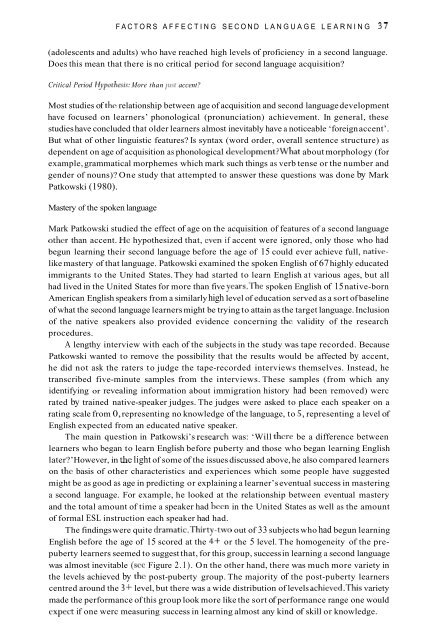English Language Teaching in its Social Context
English Language Teaching in its Social Context
English Language Teaching in its Social Context
Create successful ePaper yourself
Turn your PDF publications into a flip-book with our unique Google optimized e-Paper software.
FACTORS AFFECTING SECOND LANGUAGE LEARNING 37(adolescents and adults) who have reached high levels of proficiency <strong>in</strong> a second language.Does this mean that there is no critical period for second language acquisition?Critical Period Hypotheur: More than lu~taccent?Most studies of the relationship between age of acquisition and second language developmenthave focused on learners’ phonological (pronunciation) achievement. In general, thesestudies have concluded that older learners almost <strong>in</strong>evitably have a noticeable ‘foreign accent’.But what of other l<strong>in</strong>guistic features? Is syntax (word order, overall sentence structure) asdependent on age of acquisition as phonological development?What about morphology (forexample, grammatical morphemes which mark such th<strong>in</strong>gs as verb tense or the number andgender of nouns)? One study that attempted to answer these questions was done by MarkPatkowski (1980).Mastery of the spoken languageMark Patkowski studied the effect of age on the acquisition of features of a second languageother than accent. He hypothesized that, even if accent were ignored, only those who hadbegun learn<strong>in</strong>g their second language before the age of 15 could ever achieve full, nativelikemastery of that language. Patkowski exam<strong>in</strong>ed the spoken <strong>English</strong> of 67 highly educatedimmigrants to the United States. They had started to learn <strong>English</strong> at various ages, but allhad lived <strong>in</strong> the United States for more than five years.The spoken <strong>English</strong> of 15 native-bornAmerican <strong>English</strong> speakers from a similarly high level of education served as a sort of basel<strong>in</strong>eof what the second language learners might be try<strong>in</strong>g to atta<strong>in</strong> as the target language. Inclusionof the native speakers also provided evidence concern<strong>in</strong>g the validity of the researchprocedures.A lengthy <strong>in</strong>terview with each of the subjects <strong>in</strong> the study was tape recorded. BecausePatkowski wanted to remove the possibility that the results would be affected by accent,he did not ask the raters to judge the tape-recorded <strong>in</strong>terviews themselves. Instead, hetranscribed five-m<strong>in</strong>ute samples from the <strong>in</strong>terviews. These samples (from which anyidentify<strong>in</strong>g or reveal<strong>in</strong>g <strong>in</strong>formation about immigration history had been removed) wercrated by tra<strong>in</strong>ed native-speaker judges. The judges were asked to place each speaker on arat<strong>in</strong>g scale from 0, represent<strong>in</strong>g no knowledge of the language, to 5, represent<strong>in</strong>g a level of<strong>English</strong> expected from an educated native speaker.The ma<strong>in</strong> question <strong>in</strong> Patkowski’s rcsearch was: ‘Will there be a difference betweenlearners who began to learn <strong>English</strong> before puberty and those who began learn<strong>in</strong>g <strong>English</strong>later?’ However, <strong>in</strong> thc light of some of the issues discussed above, he also compared learnerson the basis of other characteristics and experiences which some people have suggestedmight be as good as age <strong>in</strong> predict<strong>in</strong>g or expla<strong>in</strong><strong>in</strong>g a learner’s eventual success <strong>in</strong> master<strong>in</strong>ga second language. For example, he looked at the relationship between eventual masteryand the total amount of time a speaker had been <strong>in</strong> the United States as well as the amountof formal ESL <strong>in</strong>struction each speaker had had.The f<strong>in</strong>d<strong>in</strong>gs were quite dramatic.Thirty-two out of 33 subjects who had begun learn<strong>in</strong>g<strong>English</strong> before the age of 15 scored at the 4+ or the 5 level. The homogeneity of the prepubertylearners seemed to suggest that, for this group, success <strong>in</strong> learn<strong>in</strong>g a second languagewas almost <strong>in</strong>evitable (see Figure 2.1). On the other hand, there was much more variety <strong>in</strong>the levels achieved by thc post-puberty group. The majority of the post-puberty learnerscentred around the 3+ level, but there was a wide distribution of levels achieved.This varietymade the performance of this group look more like the sort of performance range one wouldexpect if one werc measur<strong>in</strong>g success <strong>in</strong> learn<strong>in</strong>g almost any k<strong>in</strong>d of skill or knowledge.












